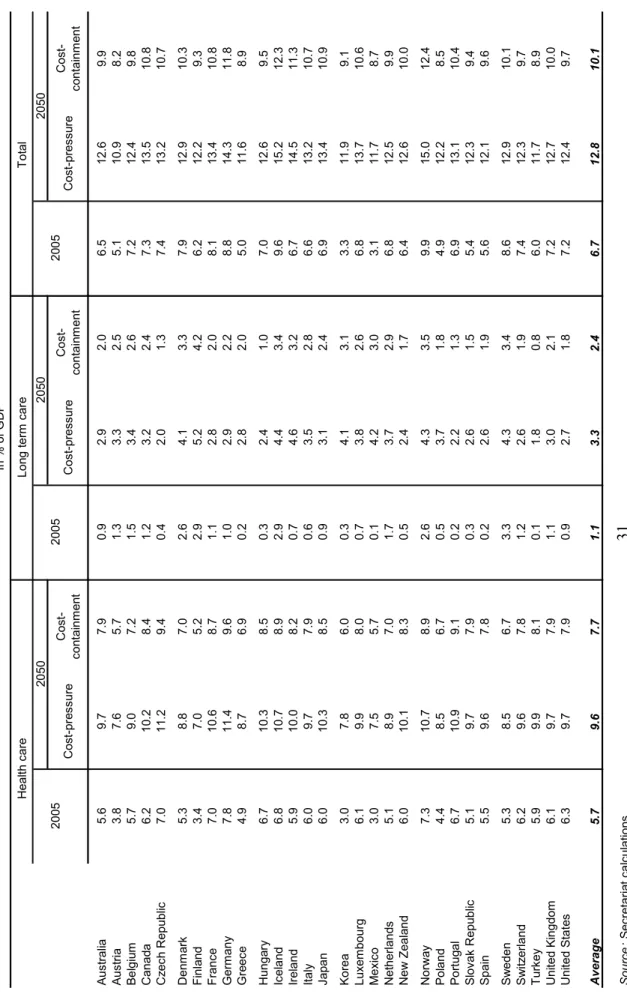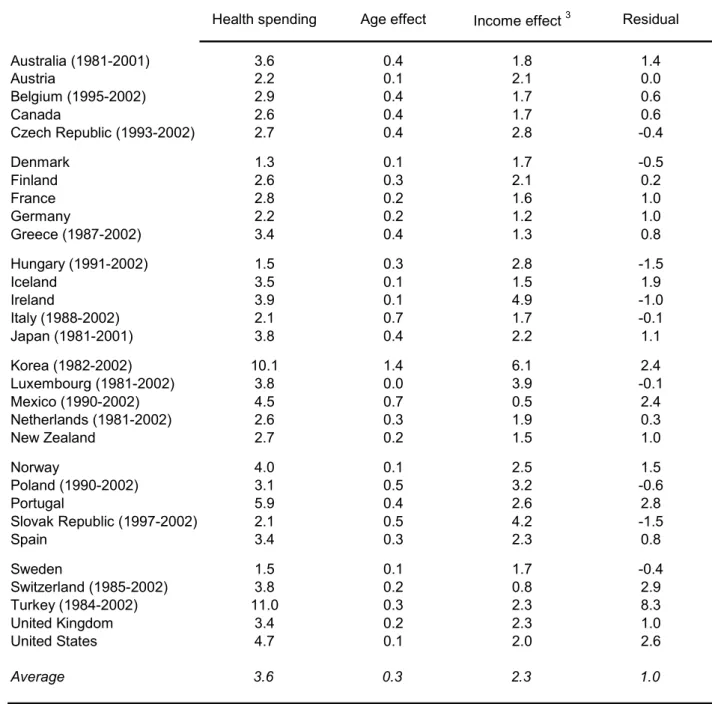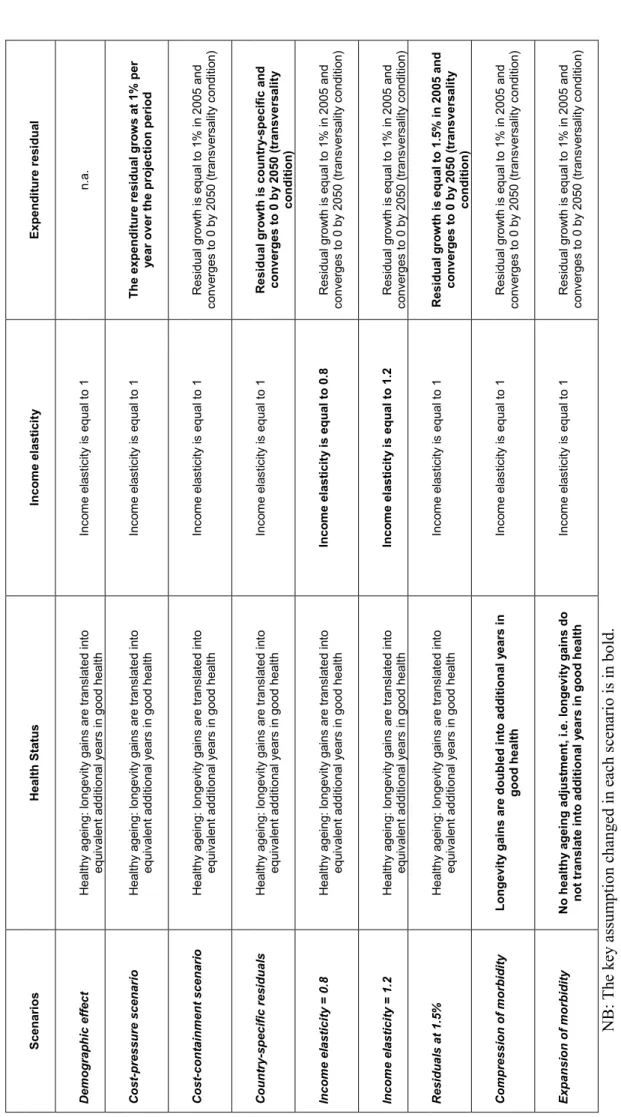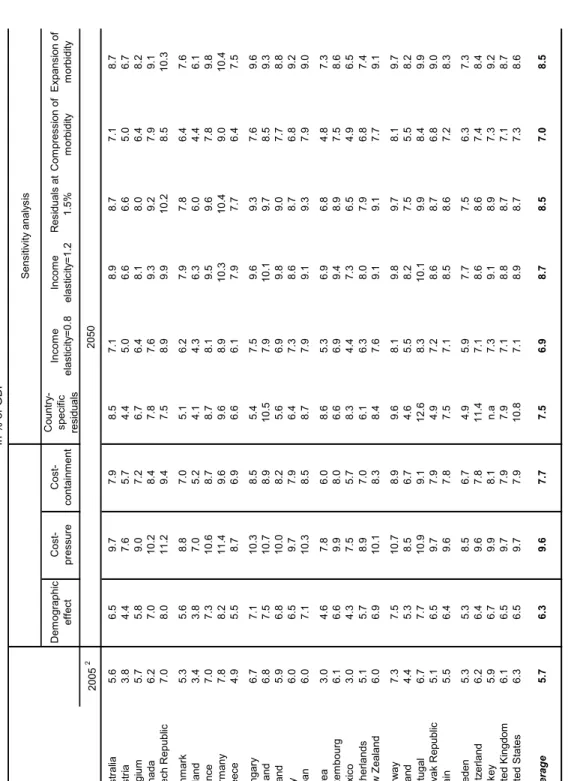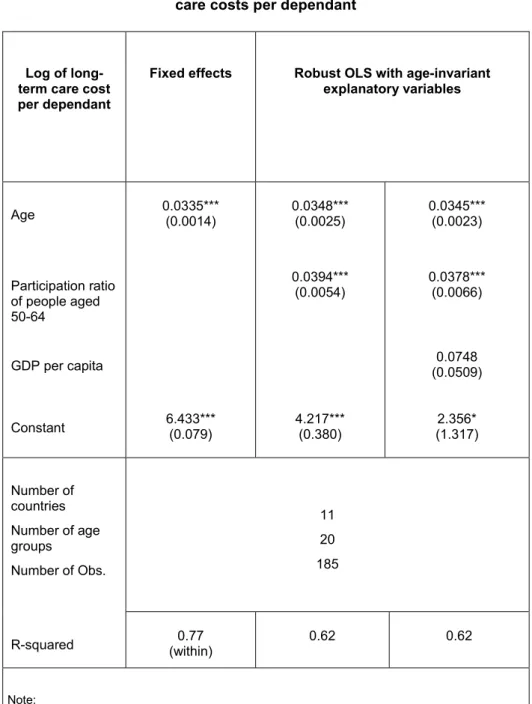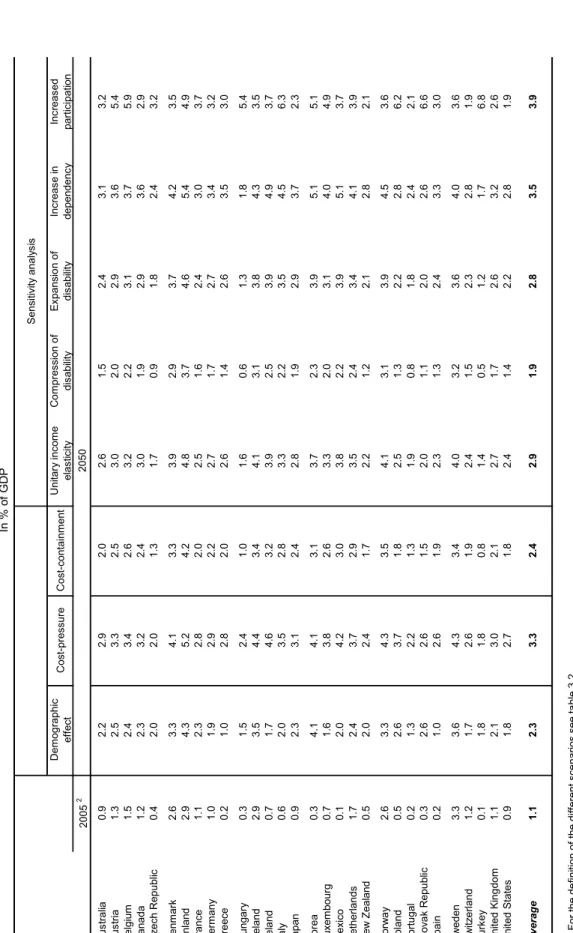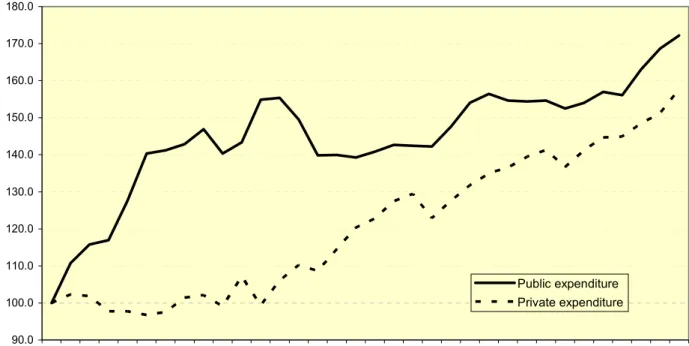Organisation de Coopération et de Développement Economiques
Organisation for Economic Co-operation and Development
___________________________________________________________________________________________
English - Or. English ECONOMICS DEPARTMENT
PROJECTING OECD HEALTH AND LONG-TERM CARE EXPENDITURES: WHAT ARE THE MAIN DRIVERS?
ECONOMICS DEPARTMENT WORKING PAPERS No. 477
All Economics Department Working Papers are available through OECD's Internet Web site at www.oecd.org/eco
ECO/WKP(2006)5 Un cl assi fi ed Eng lis h - O r. Eng
Cancels & replaces the same document of 03 February 2006
ABSTRACT/RESUMÉ
Projecting OECD health and long-term care expenditures: What are the main drivers?
This paper proposes a comprehensive framework for projecting public heath and long-term care expenditures. Notably, it considers the impact of demographic and non-demographic effects for both health and long-term care. Compared with other studies, the paper extends the demographic drivers by incorporating death-related costs and the health status of the population. Concerning non-demographic drivers of health care, the projection method accounts for income elasticity and a residual effect of technology and relative prices. For long-term care, the effects of increased labour participation, reducing informal care, and wage inflation are taken into account. Using this integrated approach, public health and long-term care expenditure are projected for all OECD countries for the years 2025 and 2050. Alternative scenarios are simulated, in particular a 'cost-pressure' and 'cost-containment' scenario, together with sensitivity analysis. Depending on the scenarios, the total health and long-term care spending is projected to increase on average across OECD countries in the range of 3.5 to 6 percentage points of GDP for the period 2005-2050.
JEL Classification: H51, I12, J11, J14
Key words: Public health expenditures, long-term care expenditures, ageing populations, longevity, demographic and non-demographic effects, projection methods.
******
Cette étude propose un cadre assez complet pour effectuer des projections de dépenses de soins de santé et de soins de long terme. Notamment, à la fois pour les dépenses de santé et les soins de long terme, les effets des facteurs démographiques et non démographiques sont considérés dans l'analyse. En comparaison avec d'autres études, les effets démographiques ont été élargis pour incorporer les coûts liés à la mortalité et à l'état de santé de la population. Pour ce qui concerne les facteurs non démographiques des dépenses de santé, la méthode de projection incorpore un effet d'élasticité-revenu et l'effet résiduel de la technologie et des prix relatifs. Pour les soins de long terme, l'effet d'une participation accrue dans le marché du travail diminuant l'offre de soins informels, et de l'inflation des salaires ont été pris en compte. Sur la base de cette approche intégrée, les dépenses publiques de santé et des soins de long terme sont projetées pour tous les pays de l'OCDE et pour les années 2025 et 2050. Des scénarios alternatifs ont été simulés, en particulier un
"scénario de pression sur les coûts" et un "scénario de contention des coûts", ainsi qu’une analyse de sensitivité. En fonction des scénarios, le total des dépenses de santé et des soins de long terme est projeté d'augmenter pour la moyenne de l’OCDE entre 3.5 et 6 points de PIB pour la période 2005-2050.
Classification JEL: H51, I12, J11, J14
Mots clefs: dépenses publiques de santé, dépenses publiques de soins à long terme, vieillissement de la population, longévité, effets démographiques et non démographiques, méthodes de projection.
Copyright OECD, 2006
Applications for permission to reproduce or translate all, or part of, this material should be made to:
Head of Publications Service, OECD, 2 rue André-Pascal, 75775 Paris Cedex 16, France.
TABLE OF CONTENTS
FOREWORD ... 5
1. Summary and main findings... 6
2. Health care... 10
Projecting demographic drivers of expenditure... 10
Projecting non-demographic drivers of expenditure... 12
Combining demographic and non-demographic drivers... 14
Alternative scenarios for OECD countries ... 15
Demographic effects ... 15
A cost pressure scenario... 16
A cost-containment scenario ... 16
Sensitivity analysis ... 17
Residuals, income elasticity and different health scenarios... 17
Alternative population projections... 18
3. Long-term care ... 18
Projecting demographic drivers of expenditure... 19
Projecting non-demographic drivers of expenditure... 20
Combining demographic and non-demographic drivers... 21
Alternative scenarios for OECD countries ... 22
Demographic effects ... 22
A cost-pressure scenario ... 23
A cost-containment scenario ... 23
Sensitivity analysis ... 23
REFERENCES ... 25
ANNEX 1. LIST OF TABLES AND FIGURES... 30
ANNEX 2A. DATA SOURCES AND METHODS... 50
Macro data ... 50
Health care... 50
Estimating the death-related costs... 50
Estimating the survivors' expenditure curves... 51
Calibration of the cost curves on the OECD Health database... 51
Projecting the demographic effects under a ‘healthy ageing’ scenario... 51
Long-term care (LTC) ... 52
Expenditure curves... 52
The starting point of the projections ... 53
Detailed results for the projection scenarios... 53
ANNEX 2B. EMPIRICAL EVIDENCE ON THE HEALTH CARE INCOME ELASTICITIES ... 73
A brief survey of the literature... 73
Econometric estimates ... 74
ANNEX 2C. OBESITY TRENDS IN OECD COUNTRIES ... 77
Boxes
Box 1. Glossary of technical terms ... 9
Box 2. Longevity and health status scenarios ... 11
Box 3. Cost-containment policies in OECD countries: an overview 1 ... 13
Box 4. Exogenous variables and assumptions underlying the projections... 15
Box 5. Has disability fallen over time? ... 20
FOREWORD
Rising expenditure on health and long-term care is putting pressure on government budgets in most OECD countries. Going forward, these pressures will add to those arising from insufficiently reformed retirement schemes. The question is how much health and long-term care spending could increase in the future and what policy can do about it. This paper presents a framework for thinking about that question and provides some quantitative illustrations. Both changing demography and non-demographic drivers of spending are taken into account.
The paper shows that spending on health and long-term care is a first-order policy issue. Between now and 2050, public spending on health and long-term care could almost double as a share of GDP in the average OECD country in the absence of policy action to break with past trends in this area. And that estimate takes into account that as people live longer, they also remain in good health for longer. Even with containment measures, public spending on health and long-term care could rise from the current average level of 6-7 % of GDP to around 10% by 2050. In some countries, the increase could be dramatic.
Despite the orders of magnitudes involved, policy discussion in many countries has focused less on health and long-term care spending than on pension and transfer spending. There can be many reasons for that.
One is possibly that pension spending is analytically more easily tractable than is the case for health and long-term care. Another is that the policy instruments to address pension spending are more readily identifiable. A third is that it is easier in the case of pensions to identify benchmarks for assessing what constitutes reasonable spending levels and sensible incentives to private sector actors. Whatever the reasons, the results in this paper illustrate that the policy environment for health and long-term care spending is of primordial importance.
The work behind this report was undertaken by a team led by Joaquim Oliveira Martins and comprising also Christine de la Maisonneuve and Simen Bjørnerud. As usual in our work, a preliminary version of the report was discussed by OECD government representatives. They provided many helpful comments, but the responsibility for the final product of course lies with the OECD Secretariat.
Jean-Philippe Cotis
Chief Economist
PROJECTING OECD HEALTH AND LONG-TERM CARE EXPENDITURES: WHAT ARE THE MAIN DRIVERS?
1. Summary and main findings
1. Public spending on health and long-term care is a major source of fiscal pressures in most OECD countries, amounting to, on average, some 7% of GDP in 2005. Evolution has been uneven over time:
following rapid growth during the 1970s, public spending slowed down for several decades. However, a recent acceleration (Figure 1.1) has raised concern about likely future trends.
[Figure 1.1 Evolution of public and private OECD health spending]
2. This paper attempts to respond to these concerns by considering a number of factors likely to drive public spending on health and long-term care over the period to 2050. 1 In projecting drivers of this spending, two important distinctions are made:
• Expenditures on long-term care and on health care (both preventive and acute) are examined separately,
• For both health and long-term care, the impacts of ageing and non-demographic factors are brought separately into the analysis.
3. The projections rely on a uniform cross-country framework, in contrast with an earlier OECD exercise. 2 The latter essentially gathered country-specific projections, provided by national authorities, produced on the basis of an agreed set of macroeconomic and demographic assumptions. The current projections are more homogeneous, but at the cost of simplifying the description of national health and long-term care arrangements. The main purpose is to bring out in a stylised and tractable way the key mechanisms at work. The inherent uncertainties surrounding this approach are addressed by analysing the sensitivity of the projection results to changes in the assumptions concerning the main drivers of expenditure.
4. In broad terms, the principal forces driving these projections are (see main text for detail):
• Health care, demographic factors: a rising share of older age groups in the population will put upward pressure on costs because health costs rise with age. However, the average cost per individual in older age groups should fall over time for two reasons:
− Longevity gains are assumed to translate into additional years of good health (“healthy ageing); and
1. This paper only deals with public spending. Private spending added another 2% of GDP on average to expenditure on health and long-term care in 2005. While it could be argued that private and public expenditures are not separable, it is implicitly assumed here that private health spending arises from individual choices and, therefore, could be treated like any other consumption item.
2. For details on this earlier project see Dang et al. (2001).
− Major health costs come at the end of life. Insofar as increasing longevity means that more individuals “exit” an age group by living into an older group (rather than “exit” by dying), average costs of the group in question will fall.
• Health care, non-demographic factors: health care costs have typically grown faster than income (even as incomes have increased). This is generally held to be due to the effect of technology and relative-price movements in the supply of health services. Disentangling these factors is beyond the scope of current analysis and indeed is dealt with only modestly in the literature. Hence, two scenarios are assumed in the projections here:
− A “cost pressures” scenario in which it is assumed that, for given demography, expenditures grow 1% per annum faster than income. This corresponds to observed trends over the past two decades.
− A “cost-containment” scenario in which (unspecified) policy action is assumed to curb this
“extra” expenditure growth such that it is eliminated by the end of the projection period (2050).
• Long-term care, demographic factors: dependency on long-term care will tend to rise as the share of old people in the population increase. This effect is mitigated somewhat by the likelihood that the share of dependents per older age group will fall as longevity increases due to
“healthy ageing”.
• Long-term care, non demographic factors: expenditures are likely to be pushed up by a possible
“cost disease” effect, i.e. the relative price of long-term care increasing in line with average productivity growth in the economy because the scope for productivity gains in long-term care is more limited. 3 This effect is assumed to be fully operative in the “cost pressure” scenario but to be partially mitigated 4 by (unspecified) policy action in the “cost containment” scenario.
5. As noted, two main sets of scenarios were simulated, one in which no policy action is assumed, the “cost pressures” scenario, and a “cost-containment scenario” that embodies the assumed effects of policies curbing expenditure growth. As mentioned above, these policies are not modelled explicitly.
Finally, sensitivity tests were carried out to assess the robustness of the results to key assumptions.
6. The projections for health and long-term care expenditures yield the following stylised results (Table 1.1):
• In the “cost-pressure” scenario average health and long-term care spending across OECD countries is projected to almost double from close to 7% of GDP in 2005 to some 13% by 2050.
• In the “cost-containment” scenario, average expenditures would still reach around 10% of GDP by 2050, 5 or an increase of 3½ percentage points of GDP.
3. Note that empirical evidence on the income elasticity of long-term care spending simply does not exist, and in most scenarios it is assumed to be zero.
4. It is arbitrarily assumed that the relative price changes by only half of productivity growth elsewhere in the economy.
5. As a comparison, on the basis of pure demographic effects, Dang et al. (2001) concluded that the
expenditure on health and long-term care for a group of OECD countries would increase from 6% of GDP
in 2000 to 9 to 9½ per cent of GDP in 2050. A similar study by the EC-Economic Policy
• Non-demographic factors (including effects from technology and relative prices) play a significant role in upwards pressure on long-term care expenditures, and indeed are the most important driver of the increase in health-care expenditure.
[Table 1.1 Public health and long-term care spending]
7. These average results hide striking differences across countries (Figure 1.2). In the cost- containment scenario, a group of countries stands out with increases of health and long-term care spending at or above four percentage points of GDP, over the period 2005-50. It includes rapidly ageing countries (Italy, Japan, Spain), countries that will experience a dramatic change in their population structure (Korea, Mexico, Slovak Republic), and countries with currently low labour participation, which may face a substantial increase in the demand for formal long-term care (Italy, Ireland, Spain). In contrast, Sweden is in the lowest range with an increase below two percentage points of GDP. This country is in a mature phase of its ageing process and already spends a relatively high share of GDP on health and long-term care.
[Figure 1.2 Total increase in health and long-term care spending, 2005-2050]
8. Despite the uncertainties, sensitivity analysis suggests the results are fairly robust in key respects.
For example, under the assumption of “healthy ageing” changes in longevity will have only a modest effect on spending. However, the projections for spending on long-term care are sensitive to the future development of participation rates for the working-age population because higher participation reduces the capacity for “informal” care. An alternative scenario, where participation rates in countries where they are currently low converge towards levels in high-participation countries, has spending on long-term care rising by an additional 1-2% of GDP on average, but much more in some countries. 6
9. The paper follows the structure displayed in Figure 1.3. It begins with health care expenditure, decomposing demographic and non-demographic expenditure drivers, discusses the main mechanisms at work in each case, and describes the projection framework. Alternative projection scenarios are then presented, followed by a discussion of the sensitivity of the results to key assumptions. The same sequence applies to long-term care expenditures. A glossary of technical terms is provided in Box 1.
[Figure 1.3 Drivers of total health and long-term care spending: key components]
Committee (2001), focusing on the EU15 area, calculated that the expenditure on health and long-term care would increase from 6½ per cent in 2000 to 8½ to 9% in 2050. Calculated in the same way, the ageing effect was estimated to be of comparable size also in Canada (Health Canada, 2001). These orders of magnitude are comparable with the results of the present study, but the underlying drivers are rather different. For an update of the assumptions and projection methodologies see EC-Economic Policy Committee (2005).
6. However, higher participation rates are likely to have positive effects on public budgets which, depending
on how they come about, may more than offset the effect via long-term care spending.
Box 1. Glossary of technical terms
Activities of daily living (ADLs) Self-care activities that a person must perform every day, such as bathing, dressing, eating, getting in and out of bed, moving around, using the toilet, and controlling bladder and bowel.
(Acute) health care Is distinguished from long-term care in the sense that acute health care aims at changing the medical condition of a person (e.g. surgery) while long-term care only compensates for lasting ability.
Baumol effect or 'cost-disease' Tendency for relative prices of some services, such as long-term care, to increase vis-à-vis other goods and services in the economy, reflecting a negative productivity differential and the equalisation of wages across sectors.
Compression of morbidity The hypothesis that increases in longevity translate into a shorter share of life lived in relatively bad health.
Death-related costs Health expenditures incurring at the end of life. One hypothesis proclaims that the apparent rise in health expenditures with age reflects the fact that death is more frequent at higher ages, not merely the fact that people are old and frail. Following this line of thought, the projected fall in mortality will damp the future impact of ageing.
Disability/dependency Inability to perform one or more ADLs without help. Specific definitions, i.e. how many ADLs, differ across countries making comparisons difficult.
Dynamic equilibrium (“healthy ageing”) The hypothesis that the number of years of life lived in bad health remains constant in the wake of increased longevity (or increased life expectancy is translated into additional years in good health).
Expansion of morbidity The hypothesis that increases in longevity translate into a higher share of life lived in relatively bad health.
Formal long-term care Long-term care services supplied by the employees of any organisation, in either the public or private sector, including care provided in institutions like nursing homes, as well as care provided to persons living at home by either professionally trained care assistants, such as nurses, or untrained care assistants. Divided into home care and institutional care.
Informal care Long-term care provided by spouses/partners, other members of the household and other relatives, friends and neighbours. Informal care is usually provided at the home and is typically unpaid.
Long-term care A range of (often basic) services needed for persons who are dependent on help for carrying out basic ADLs. Divided into formal and informal long-term care where, on average across OECD countries, the latter currently makes up the bigger part.
Morbidity/chronic conditions A wider concept than disability. Higher levels of disability are generally accompanied by more chronic conditions, but the opposite does not necessarily follow; intensive medical treatment can reduce disability by soothing chronic diseases. This implies that a decline in disability does not necessarily means curtailment in costs. Still, analyses usually focus on disability due to lack of reliable and objective measures of morbidity.
Prevalence of disability/morbidity/
dependency
Number of cases of disability/disease/dependency for a given population for a given
time period. Prevalence of disability/morbidity/dependency tends to be more frequent
at higher ages.
2. Health care
10. Looking at the recent past, expenditures on health care have increased in terms of their share in GDP. Given that pure demographic factors have so far been weak, this upward trend in spending is probably due to the increased diffusion of technology and relative price changes. Two important questions are then: how will these typically non-demographic drivers behave in the future and will the projected change in demographic trends create additional expenditure pressures?
Projecting demographic drivers of expenditure
11. While the effect of ageing on public health expenditures per capita has been weak in the past, 7 it is commonly expected that it will increase in the future. This assessment is based on the combined effect of the projected increase in the share of old people and the tendency for health expenditures per capita to increase with age. 8
12. In this study expenditure profiles are a central piece of the projection framework (Figure 2.1).
Average health expenditures by age group are relatively high for young children; they decrease and remain stable for most of the prime-age period, and then start to increase rapidly at older ages. 9
[Figure 2.1 Public health care expenditure by age groups]
13. For any given year, the population can be divided into two segments: the survivors and the non- survivors. Each of these segments of the population has a specific cost curve. The non-survivors' cost curve can be estimated by multiplying the estimated costs of death by age group by the number of deaths per age group. In line with evidence that health costs are concentrated in the proximity to death (i.e., they are
“death-related”; Seshamani and Gray, 2004; Batljan and Lagergren, 2004), the cost of death was proxied by the health expenditure per capita for the oldest age group (95+) multiplied by a factor (equal to 4 for an individual between 0 to 59 years old and declining linearly to 1 afterwards). The survivors' cost curve can then be derived from the difference between the total cost curve and the non-survivor curve (see Annex 2A). An example of this split is given for one country, Finland, in Figure 2.2. Using this framework, health expenditures for survivors and non-survivors can be projected separately in a more meaningful way.
[Figure 2.2 Breakdown of the health care cost curve]
7. See Culyer (1990), Gerdtham et al., (1992), Hitiris and Posnett (1992), Zewifel et al. (1999), Richardson and Roberston (1999), Moise and Jacobzone (2003) and Jönsson and Eckerlund (2003).
8. Across all health expenditure types, expenditure on those aged over 65 is around four times higher than on those under 65. The ratio rises to between six to nine times higher for the older groups (Productivity Commission, 2005; OECD Health Database, 2005).
9. The data is based on the EU-AGIR Project; see Westerhout and Pellikaan (2005). The complete expenditure profiles were only available for a subset of OECD countries. A number of different adjustments and estimations were made in order to derive these curves for other OECD countries.
Moreover, for some countries only total costs were available and thus health care had to be separated from
long-term care. For 12 countries, the data were simply not available. In this case, the expenditure curves
were estimated by adjusting expenditures as a spline function of age, based on available data, and were
calibrated on the basis of total health expenditures derived from OECD (2005a). These estimation
procedures are described in detail in Annex 2A.
14. The shape of the aggregate cost curves can be explained by movements across age groups in health care expenditures for these two segments of the population. Indeed, the upward shape of the average cost curve reflects the fact that mortality rates are higher for older age groups. At the same time, the fact that the cost curves tend to peak and then decline at very old ages can be explained by considerations related to the cost of death. While the probability of dying increases with age, the costs of death tend to decline steadily after young and prime ages (Aprile, 2004). Finally, the little spike in health expenditures at the youngest age is related in part to infant mortality being higher than prime-age mortality.
15. Noteworthy, the death-related costs hypothesis has logical implications for the health status of survivors. In the extreme case where health costs are only death-related, there are only two outcomes: an individual either dies or survives in good health. To be consistent over time the projected increase in life expectancy must be accompanied by an equivalent gain in the numbers of years spent in good health.
Otherwise, an increasing share of the population living in “bad health” would emerge. Average health care costs would then cease to be mainly driven by the costs of death, as initially assumed.
16. Thus, the death-related costs hypothesis implies that longevity gains are translated into years in good health. Under this “healthy ageing” scenario, the cost curve for survivors is allowed to shift rightwards, progressively postponing the age-related increases in expenditure. 10 This development tends to reduce costs compared with a situation in which life expectancy would not increase. Other health status scenarios have been envisaged in previous research (see Box 2) and the projections in this paper test the sensitivity of the results to these alternative assumptions.
17. As regards non-survivors, two different demographic effects are at play. On the one hand, the number of deaths is set to rise due to the transitory effect of the post-war baby-boom. On the other hand, if mortality falls over time, due to a permanent increase in longevity, fewer will be at the very end of life in each given year, mitigating health care costs. 11 The total effect on public health care expenditures will depend on the relative size of these effects.
Box 2. Longevity and health status scenarios
Different health status scenarios have been envisaged in the literature. In an “expansion of morbidity” scenario (Grunenberg, 1977), the share of life spent in bad health would increase as life expectancy increases, while a
”compression of morbidity” scenario (Fries, 1980) would mean the opposite. Currently, equilibrium between longevity and morbidity is observed in many OECD countries. Accordingly, and striking a compromise between the expansion and compression scenarios, Manton (1982) put forward the ”dynamic equilibrium” hypothesis where longevity gains are translated one-to-one into years in good health (hereafter, referred as ”healthy ageing”).
In this context, Michel and Robine (2004) proposed a general approach to explain why countries may shift from an expansion to a contraction of morbidity regime, or achieve a balanced equilibrium between longevity gains and the reduction of morbidity. They identified several factors at work: i) an increase in the survival rates of sick persons which would explain the expansion in morbidity; ii) a control of the progression of chronic diseases which would explain a subtle equilibrium between the fall in mortality and the increase in disability; iii) an improvement in the health status and health behaviour of the new cohorts of old people which would explain the compression of morbidity, and eventually; iv) the emergence of very old and frail populations which would explain a new expansion in morbidity.
Depending on the relative size of each of these factors, countries could evolve from one morbidity regime to another.
10. In contrast, in a “pure demographic” approach to health care expenditures, the cost curves would not shift rightwards with ageing, reflecting the implicit assumption of unchanged health status at any given age.
When the cost curves stay put in presence of longevity gains, the share of life lived in ‘bad health’
increases when life expectancy increases.
11. See for example Fuchs (1984), Zwiefel et al. (1999), Jacobzone (2003) and Gray (2004).
Projecting non-demographic drivers of expenditure
18. Income growth is certainly the main non-demographic driver of expenditures, although the vast literature on this topic is still somewhat inconclusive on the precise value of the income elasticity (see Annex 2B). Two insights can, nevertheless, be drawn. First, income elasticity tends to increase with the level of aggregation, implying that health care is both “an individual necessity and a national luxury”
(Getzen, 2000). Second, without reliable price data for health-related goods and services, the high income elasticities (above unity) often found in macro studies may result from the failure to control for true price effects. In this context, the most reasonable approach seems to assume unitary income elasticity and, subsequently, to test the sensitivity of the projections to this assumption.
19. After controlling for demographic and income effects, a residual expenditure growth can be derived. Between 1981 and 2002 (Table 2.1), public health spending grew on average by 3.6% per year for OECD countries, 12 of which 0.3 percentage point was accounted by pure demographic effects 13 and 2.3 percentage points by income effects (assuming unitary income elasticity). Thus, the residual growth can be estimated at around 1% per year. Over an extended sample, 1970-2002, the residual growth would much higher to reach 1.5% per annum (Table 2.2). This difference reflects the implementation of cost- containment policies over part of the 1980s and the 1990s that curbed the strong residual growth of the 1970s (Box 3).
[Table 2.1 Decomposing growth in public health spending, 1981-2002]
[Table 2.2 Decomposing growth in public health spending, 1970-2002]
20. What are the factors underlying this residual expenditure growth? The main culprits seem to be technology and relative prices. 14 Indeed, the gains in health status discussed above do not only arise from improvements in lifestyle (Sheehan, 2002; Cutler, 2001), but also from advances in medical treatment/technology. The latter, however, do not come free of economic cost. Technical progress can be cost-saving and reduce the relative price of health products and services, but its impact on expenditure will depend on the price elasticity of the demand for health care. If it is high, a fall in prices will induce a more than proportionate rise in demand, increasing expenditures. 15 Even if prices do not fall, new technologies may increase demand by increasing the variety and quality of products. 16,17
12. This estimate was carried out for total health spending given that the split between health care and long- term care expenditures is not available in time series for historical data. Given the low share of public long- term care expenditure to GDP in 2000 (typically below 1% of GDP; OECD, 2005b), this approximation of the residual growth seems reasonable.
13. To simplify calculations, the effect of past ageing does not incorporate “healthy longevity” and “death- related cost” as is done in the projections. In any event, the ageing effect was small and would have even been even smaller if a more sophisticated method had been applied. If anything, ceteris paribus, ignoring these past factors is likely to have lead to a downward bias in the estimated residual.
14. See Fuchs (1972) and Mushkin and Landefeld (1979). More recently, there has been a renewal of interest in this approach, see Newhouse (1992), KPMG Consulting (2001), Wanless (2001), Productivity Commission (2005a-b).
15. For example, Dormont and Huber (2005) found that in France the unit price of certain surgical treatments, such as cataract, decreased whereas the frequency of the treatments increased significantly. Such effects can explain much of the recent upward shift in the health care cost curves in France.
16. This is equivalent to say that the “true” relative price of health care vis-à-vis all other goods in the economy decreases. Consider for example the case of a demand for variety model with a CES utility function:
∑
−=
i
